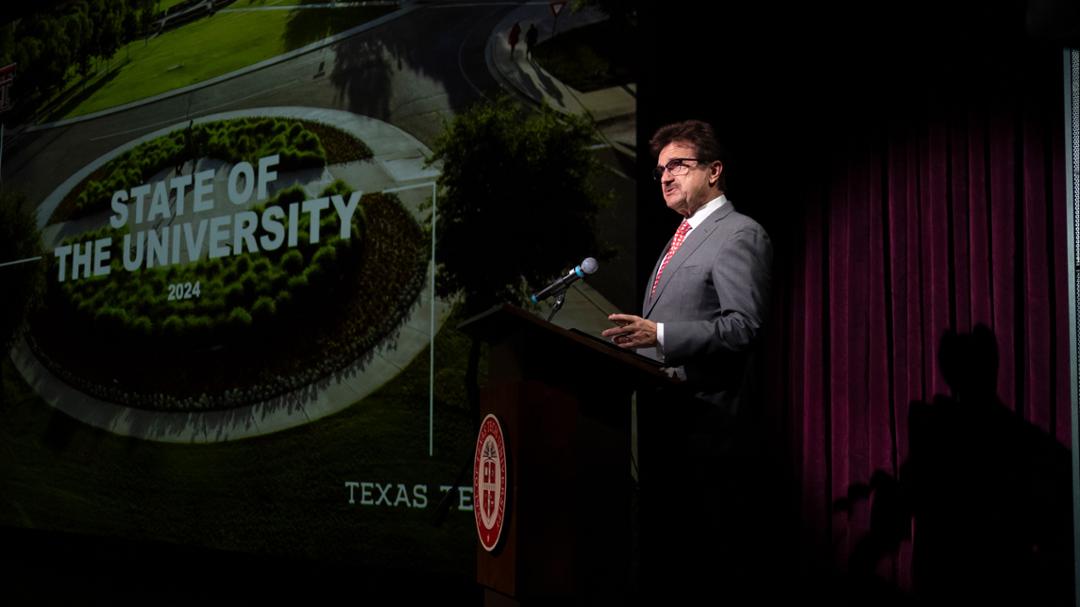Texas Tech University President Lawrence Schovanec delivered the address as the university builds on its first 100 years of excellence.
Texas Tech University’s first 100 years were replete with milestones throughout academia, research and athletics. Those milestones were accomplished through a combination of grit, energy and steadfast determination.
As Texas Tech enters its second century, those same characteristics have placed the university among the world’s leaders, and as highlighted during President Lawrence Schovanec’s State of the University address on Wednesday (Sept. 25), it is only the beginning.
Speaking to faculty, staff, students and alumni, Schovanec highlighted Texas Tech’s biggest accomplishments over the past year and the people who helped make them happen, while laying out a bold vision for the years to come.
Enrollment & Graduation
In the challenging landscape of preparing students to be leaders in a globally competitive workforce, Texas Tech continues to excel. Over the last 10 years, enrollment at Texas Tech has increased by 24%, despite declining numbers of traditional college-aged students.
Earlier this month, Texas Tech announced a record enrollment, including about 12,500 students who are new to the university. This year’s freshman class is 32% first-generation. The undergraduate enrollment includes more than 10,000 new students, of which 6,000 are Presidential Merit Scholars. There are now more than 100 National Merit Finalists on campus.
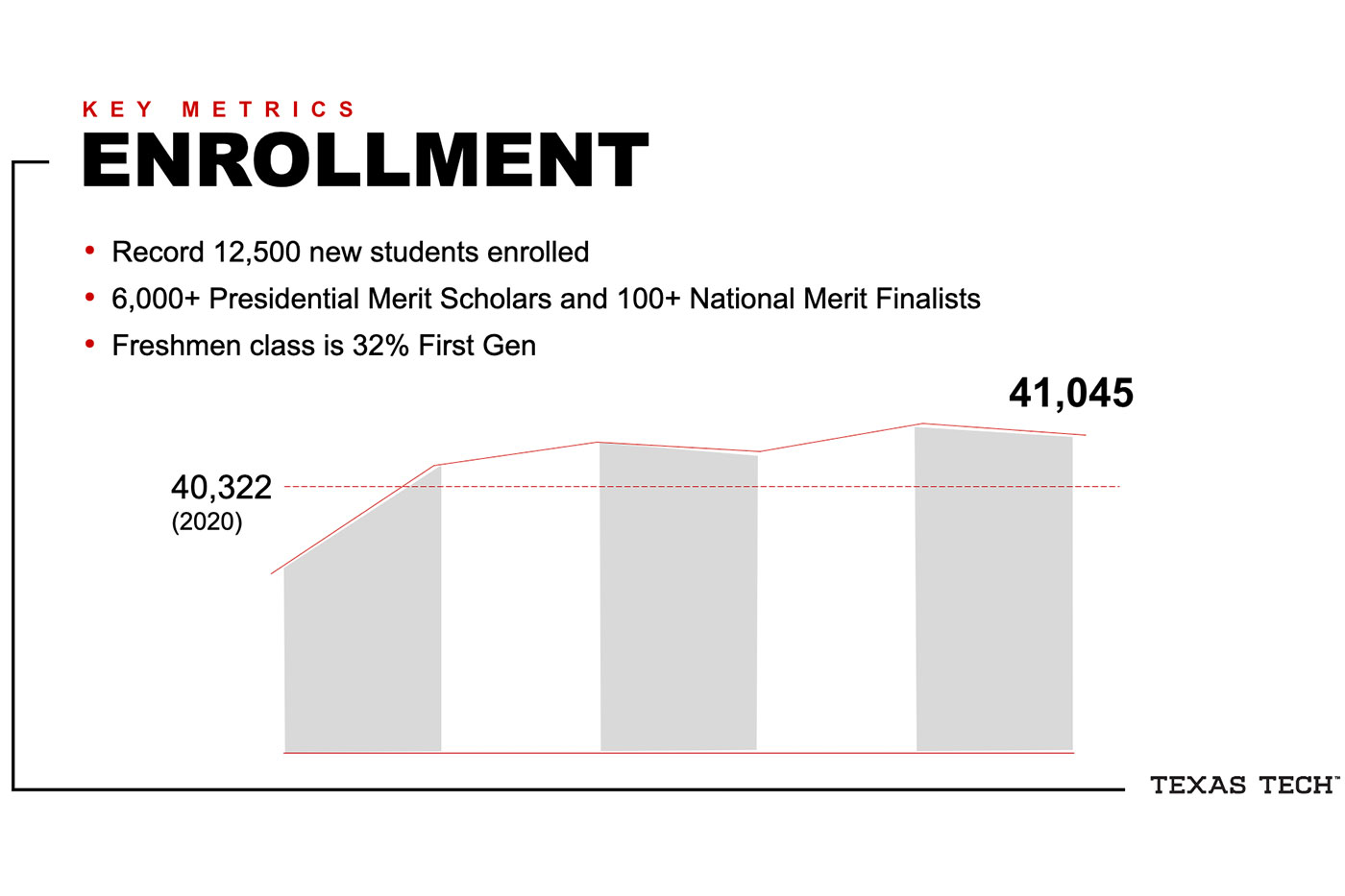
“The makeup of our student body tells us we’re responding to changing demographics by strategically reaching a broader range of students, including non-traditional learners and those who left college before completing a degree,” Schovanec said. “This is reflected in one of our largest-ever transfer classes, and we also welcomed the highest number of returning students.”
Not only is Texas Tech welcoming record numbers of students, it also is sending increased numbers of graduates into the workforce ready to make a difference in the world.
Texas Tech’s four-year graduation rate has increased by 11% and its six-year graduation rate is up 5% over the last five years. Last year, Texas Tech awarded more than 10,000 degrees and certificates to more than 9,800 students, an increase of more than 40% over the last decade.
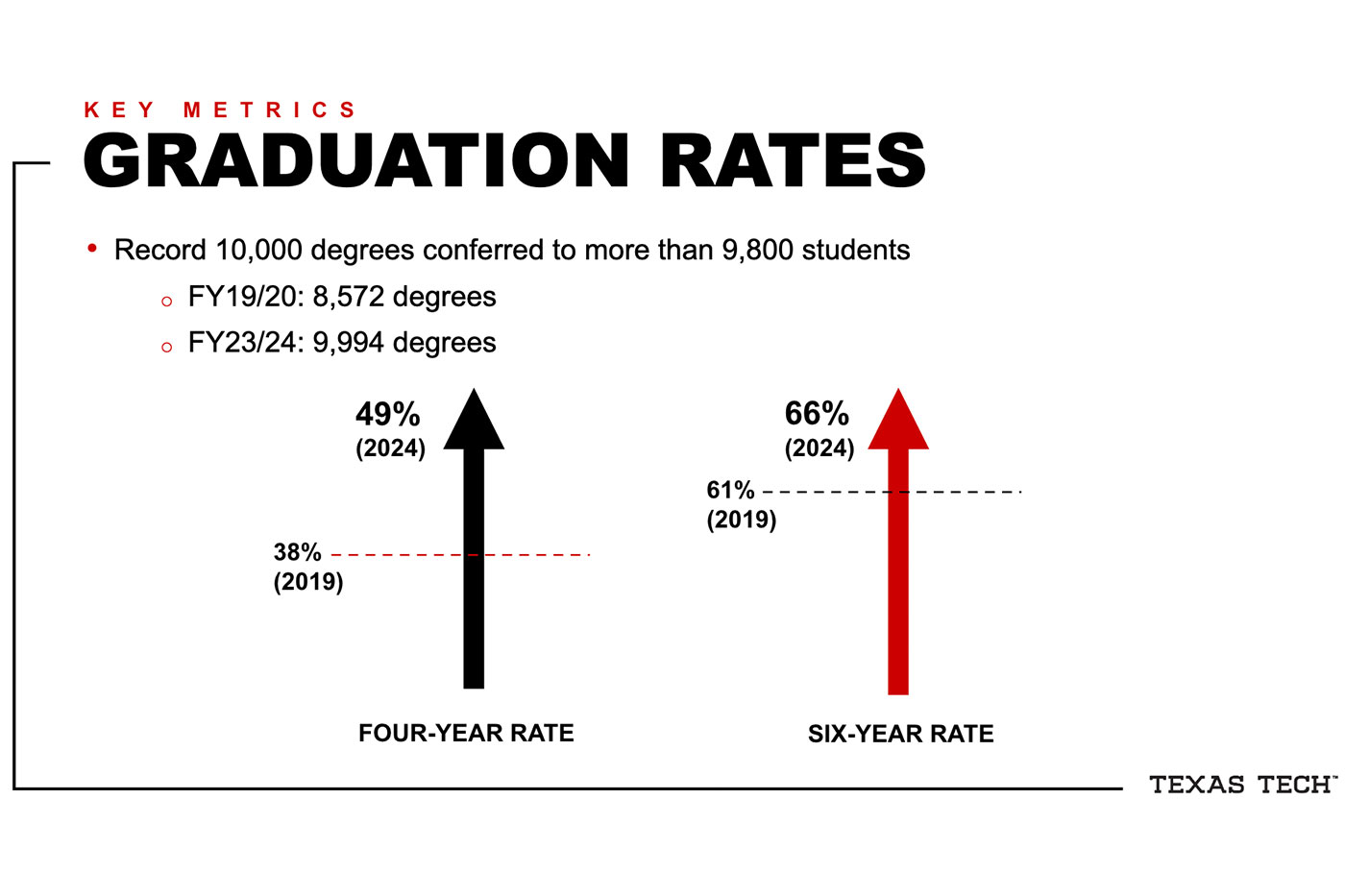
“We continue to place students first and provide an educational experience that ensures they have the skills to succeed in their chosen careers,” Schovanec said.
Research & Philanthropy
This past year, Texas Tech secured more than $83 million in federal awards and more than $122 million in total research awards, more than double the number just a decade ago. The university’s federal research expenditures total more than $63 million and total research expenditures also are a record, reaching more than $255 million.
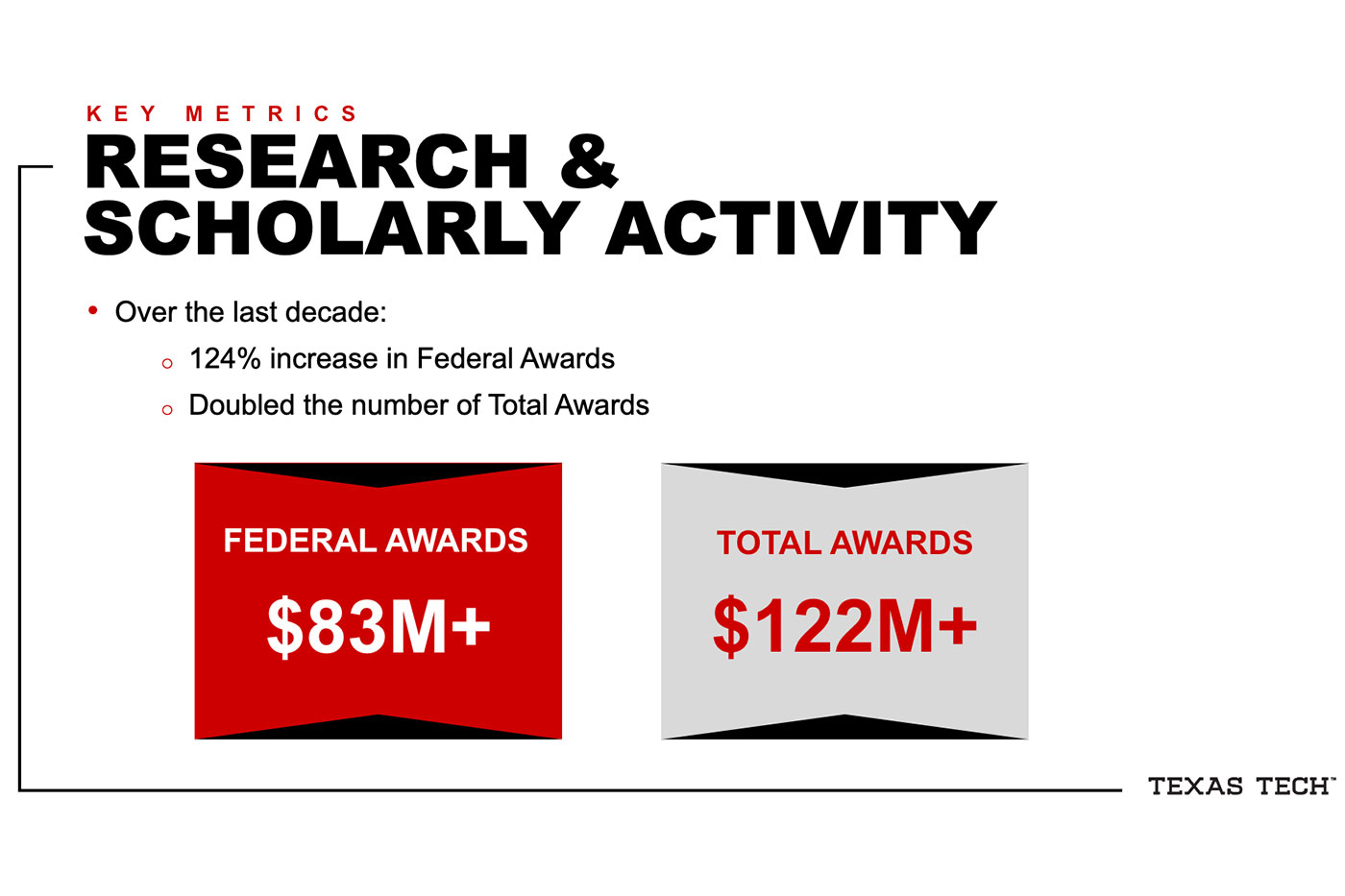

And while research activities are breaking new ground, so is the support of the community. Texas Tech has once again benefited greatly from the generosity of its alumni and supporters, with fundraising efforts yielding $176 million in the past year – the second most philanthropic dollars ever raised at Texas Tech.
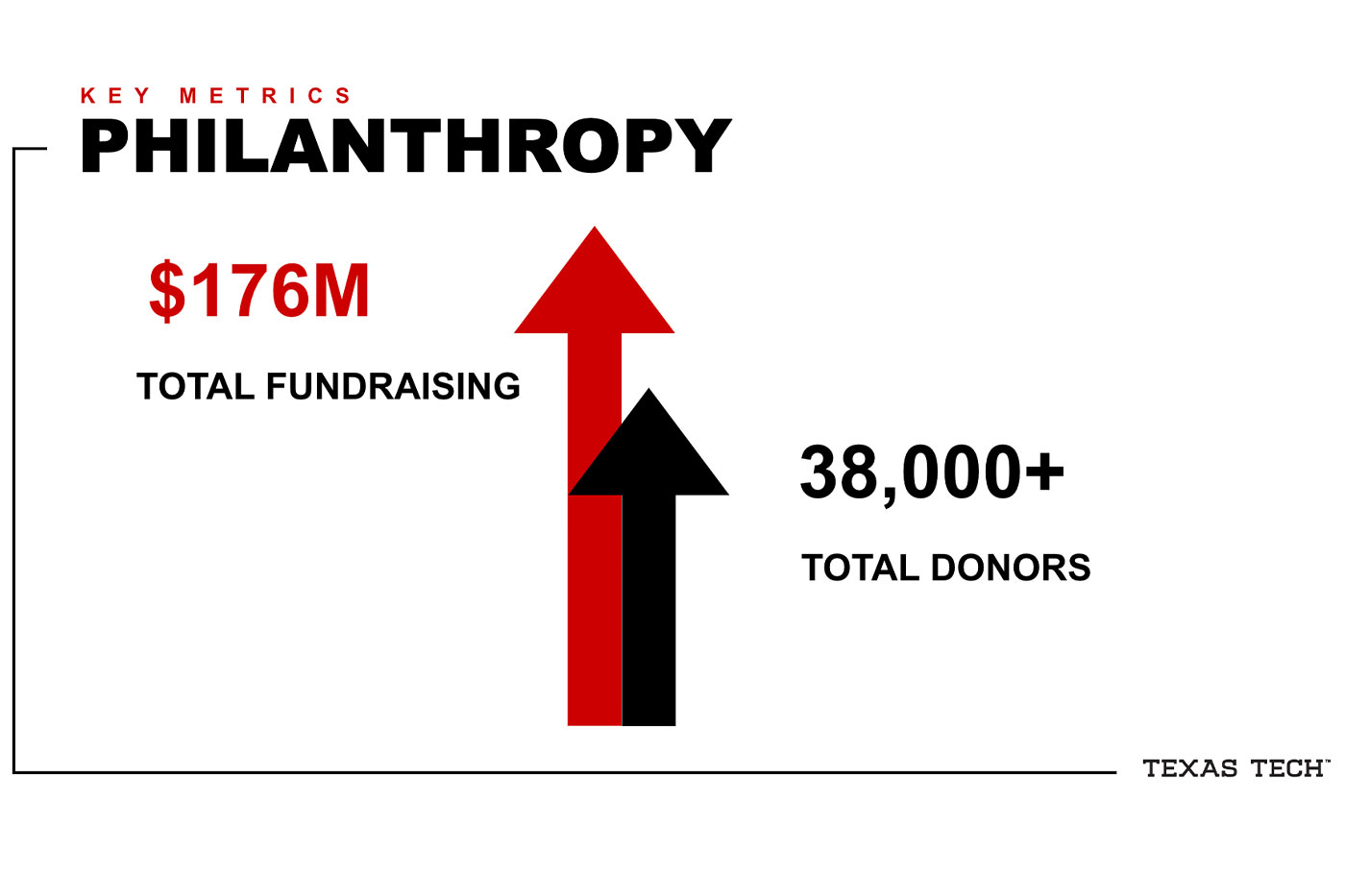
“These funds significantly impact our ability to provide scholarships, enhance our facilities and support research,” Schovanec said “These numbers represent progress in our mission. They set the stage for the ambitious plans and initiatives Texas Tech has for its future.”
Strategic Enrollment Planning
As the landscape of higher education continues to evolve, Texas Tech must strategically plan for its future enrollment.
In 2023, the university initiated a year-long strategic enrollment planning effort with the goal of optimizing enrollment strategies so that Texas Tech remains an institution of choice for students and that the practices and programs offered will ensure their future success.
“We want our student body to be the size and composition that best serves our mission and meets the needs of our state and nation,” Schovanec said. “Through this process, we learned that if we do nothing differently, by 2028, we could see a significant drop in enrollment.”
Determined to make sure that doesn’t happen, Texas Tech developed six key strategies. These strategies focus on:
- Enhancing the university’s digital marketing and recruitment efforts,
- Driving program innovation, including several new degrees that offer alternative pathways for students,
- Optimizing Texas Tech’s financial aid and scholarship distribution,
- Increasing retention rates through targeted interventions,
- Establishing a dedicated online school with flexible learning options,
- Expanding financial literacy efforts for all students.
Schovanec pointed to the progress made in the Honors College and its increasing enrollment as a testament to the effectiveness of marketing the unique opportunities available at Texas Tech. He lauded assistant dean Chad Cain and the Honors College team for their efforts, which resulted in a nearly 14% increase, the first time in the college’s 25-year history that enrollment has exceeded 2,000 students.
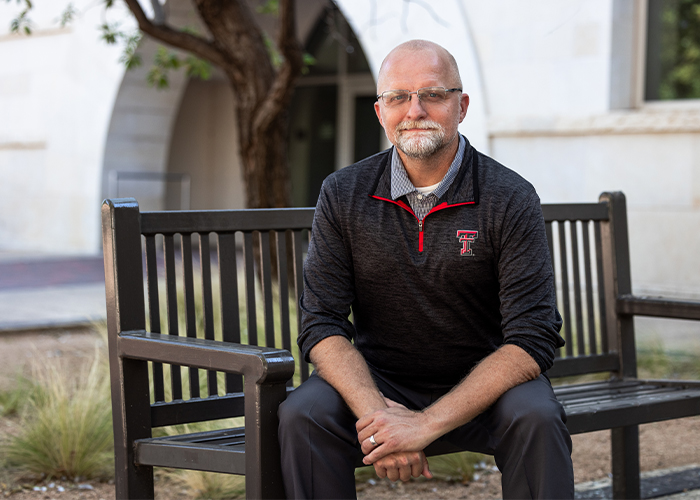
“Innovative recruitment strategies and collaborations with admissions and financial aid were instrumental to this success,” Schovanec said. “Their growth in both size and academic caliber is a testament to the reputation of both the Honors College and Texas Tech and the great work of their faculty and staff.”
Schovanec emphasized that strategic enrollment management is about more than numbers. It’s about the opportunities afforded to Texas Tech students.
He said that by 2028, the university’s enrollment could increase, and how that happens is the key. Texas Tech is focused on increasing its reach in many ways, including offering alternative pathways, both for students on this campus who change their academic degrees or non-traditional students who may decide to pursue a degree while already in their career.
Texas Tech is launching new undergraduate programs that will provide students an advantage as they enter the workplace. For example, the university now offers the opportunity for all students to receive Industry Career Certificates at no cost.
These certificates are offered by some of the biggest names in the business world – Amazon, Google, IBM, Meta, Keller Williams and more, focused on in-demand skills in areas such as cybersecurity, software development, data analytics and others.
“Student success remains at the core of our mission, and we’re seeing more students return to complete their degrees and excel in their studies, thanks to targeted support programs,” Schovanec said.
Schovanec pointed to one student as an example of how this strategic initiative can help. McLain Ford first enrolled at Texas Tech in 2011 but didn’t finish her degree. Now, through the new $10K Degree Completion program launched at Texas Tech’s new DFW location, Ford is taking advantage of the opportunity to finish her degree in a way that is more affordable and accessible for those with some college credit but no degree.
“It’s been a personal goal of mine for a very long time to complete my undergraduate degree,” Ford said. “I’m a working mom with two small children, and I want to lead by example and show them that it’s never too late to accomplish your dreams.”
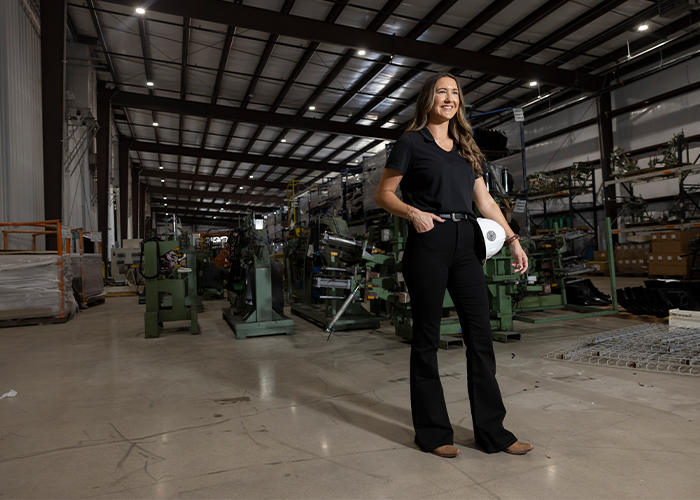
This is just one example of Texas Tech’s commitment to serving all Texans and expanding educational opportunities across the state.
Capital Campaign
Texas Tech will soon launch a comprehensive campaign to build on recent fundraising successes to support scholarships, research initiatives and academic programs. Texas Tech is four years into the silent phase of the campaign, having raised $700 million from nearly 75,000 donors.
“The first priority will be increasing the resources we can bring to bear to recruit and support our students,” Schovanec said. “The conflating factors of cost, decreasing numbers of high school graduates, and competitive recruitment pressures from institutions in and outside of Texas make scholarship support more important than ever.”
This year, Texas Tech has awarded more than $200 million in scholarships and grants, benefiting 76% of its students. Schovanec said Texas Tech must be more competitive when it comes to scholarships to ensure the Red Raider experience can be scaled to match the needs of the student body, increase academic opportunities, and improve student success.
In addition to Ford, Schovanec highlighted two other students as examples of where this campaign can be most effective.
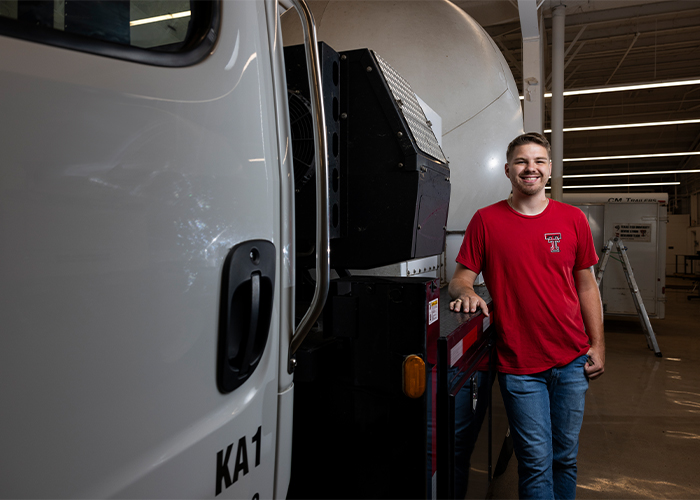
Josh Ostaszewski, a doctoral student in Atmospheric Science in the Department of Geosciences, has participated in several field projects, including this past spring when he traveled throughout the Central Plains with a team led by Professor Chris Weiss, collecting valuable wind measurements from tornadoes using Texas Tech’s mobile radar systems.
The goal of the project was to better understand tornado formation and the factors that signal their development to improve the accuracy of warnings and develop more effective building codes and shelter designs. This research proved invaluable as West Texas experienced two devastating tornadoes – in Matador and Perryton – last year. Ostaszewski also is a member of the Texas Tech Hurricane Research Team, which collected data during July’s Hurricane Beryl in South Texas and, at the time of Schovanec’s address, was deployed to Florida’s gulf coast in anticipation of Hurricane Helene making landfall.

Shaylin Romero, an undergraduate in the College of Media & Communication, is the daughter of immigrants from the Dominican Republic. She is the first person on either side of her family to attend college; she picked Texas Tech because of the personal connections and opportunities she found.
Shaylin is a member of the Red Raider Orientation crew and the Dean’s Student Ambassadors. As a Creative Media Industries major, she studied abroad in South Africa, recording the experiences of geology students for a documentary on the importance of learning outside the classroom.
“My ultimate goal, wherever I go, is to give back and help others,” Romero said. “I want to tell stories with a camera and bring more exposure to the people of the world who don’t get the opportunity to tell their stories.”
“Shaylin, Josh and McLain’s success – and that of all our students – is a priority,” Schovanec added. “But through this campaign, we also will prioritize support for our efforts to grow the quality and quantity of scholarly and research activities. In turn, this will help us to achieve our aspirational pursuits.”
Other aspirational pursuits Schovanec mentioned within the campaign include those related to infrastructure improvements through a campus master plan.
Ensuring that campus facilities not only meet current demands but also are adaptable to future needs is vital to Texas Tech’s continued growth. A thoughtfully designed campus supports academic and research priorities and enhances the student experience.
Texas Tech has invested more than $900 million into campus facilities since Schovanec became president eight years ago. That includes the recently opened Academic Sciences Building (ASB), which is the result of input from faculty and staff to ensure the needs of students and the five departments housed within that building are met. It is the first new building opened on campus during Texas Tech’s second century.
Bold Vision
In addition to philanthropic dollars, it’s essential that Texas Tech leverage institutional and state resources, including the Texas University Fund (TUF), to recruit, retain and support faculty.
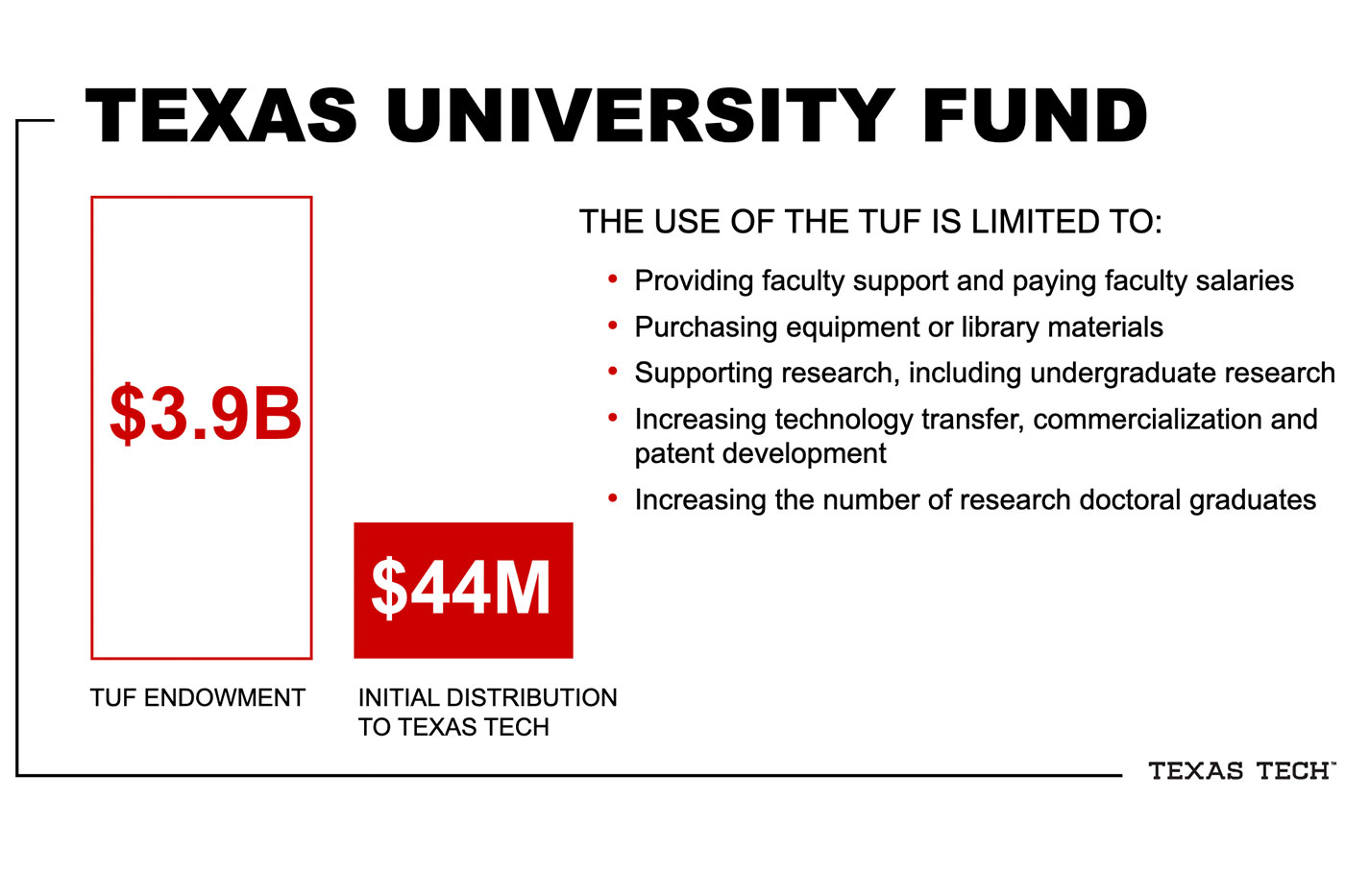
The nearly $4 billion TUF provides unprecedented opportunities to enhance research capabilities, improve facilities and invest in people.
“The projects approved under TUF cover a range of categories, including equipment acquisition, faculty support, research support services and development of research infrastructure,” Schovanec said. “We plan to add about 100 new faculty lines over the next five years. Some of those lines represent an ongoing strategic hiring process, but roughly 60 new hires will be made possible by TUF proceeds.”
Schovanec said that Texas Tech has earmarked a portion of that money to add staff in critical areas such as Accounting Services, Procurement and Operations to support the increased research activities happening on campus.
As Texas Tech has realized this initial TUF investment, and in alignment with its strategic research themes, it has launched two new institutes – the Institute for One Health Innovation (IOHI) and the Institute for Critical Infrastructure Security (ICIS).
Led by Naima Moustaid-Moussa, and in collaboration with the Texas Tech University Health Sciences Center, the IOHI focuses on the interconnections between human, animal and environmental health. It represents a true importance in this region –economically and in terms of quality of life – as many key industries rely on areas where Texas Tech brings humans in close contact with animal populations.
The ICIS, led by Stephen Bayne, will work to develop solutions to protect the nation’s most critical infrastructure by providing a competitive edge to U.S. industry, government agencies, and the public by accelerating the discovery of real interventions for these types of threats.
“In many ways, both institutes are tied to the challenges of this region, the state, nation and the world,” Schovanec said. “We are committed to building these strategic research areas into something that will have lasting value to both rural and urban communities.”
AAU and Beyond
Schovanec expects the university’s growing research enterprise, highlighted by Texas Tech’s records in research awards and expenditures, will help the university achieve status as a preeminent national research university with the goal of reaching the benchmarks shared by institutions in the Association of American Universities, more commonly known as AAU.
“AAU criteria serve a purpose for assessing our progress and establishing ever higher aspirations,” Schovanec said. “But scholarly excellence and societal impact are the most important measures of our success.”

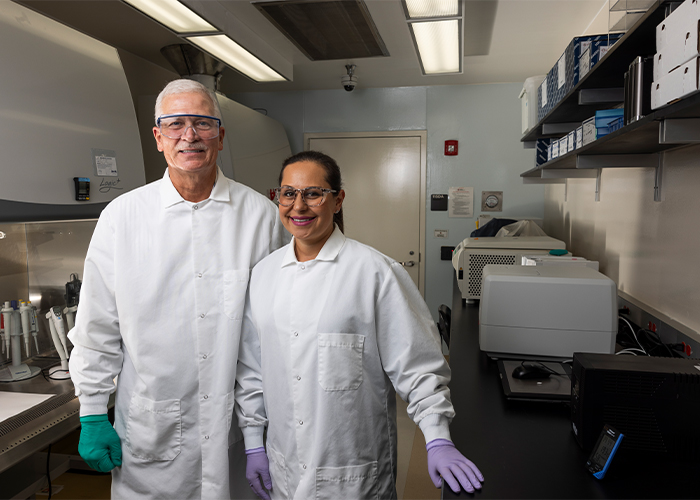
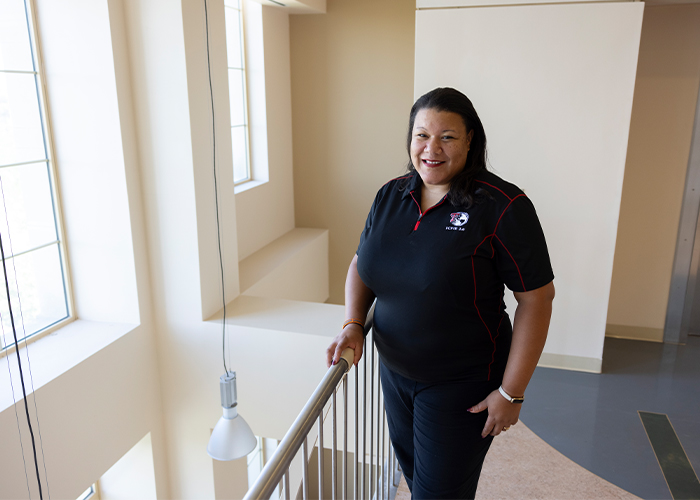
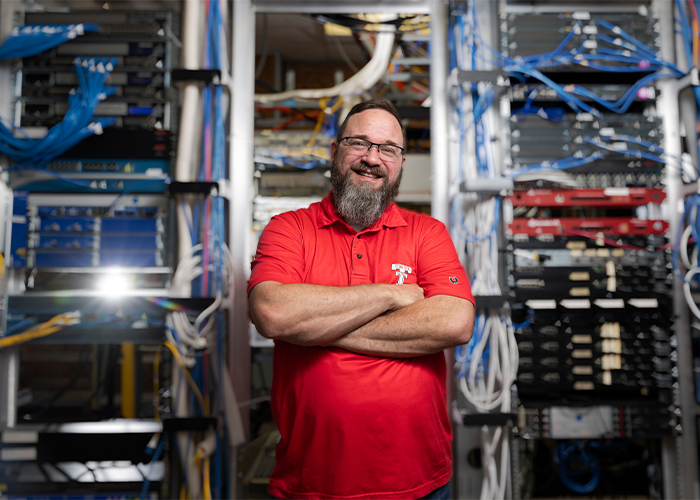
Schovanec pointed to a few Texas Tech faculty and staff members as examples:
- Joe Gauthier, an assistant professor in the Department of Chemical Engineering, has had more than 10 papers published this year that could lead to a transition from fossil-fuel-based energy to renewable energy and reduced carbon emissions, paving the way to a more sustainable future.
- Steve Presley and Cynthia Reinoso Webb from Texas Tech’s Biological Threat Research Laboratory (BTRL) co-authored an article, published in the New England Journal of Medicine, that documented the first confirmed case of highly pathogenic avian influenza transmission from dairy cattle to a human.
- Angela Shaw is a professor in the Department of Animal & Food Sciences. Her work in food safety has real-world implications, enhancing public health and safety.
- John Sallee is an assistant director in Information Technology’s enterprise network services. He and his team oversee every networking device across campus. Their commitment to maintaining and advancing Texas Tech’s network infrastructure is a testament to the integral role that the university’s skilled IT division plays in supporting academic and research missions.
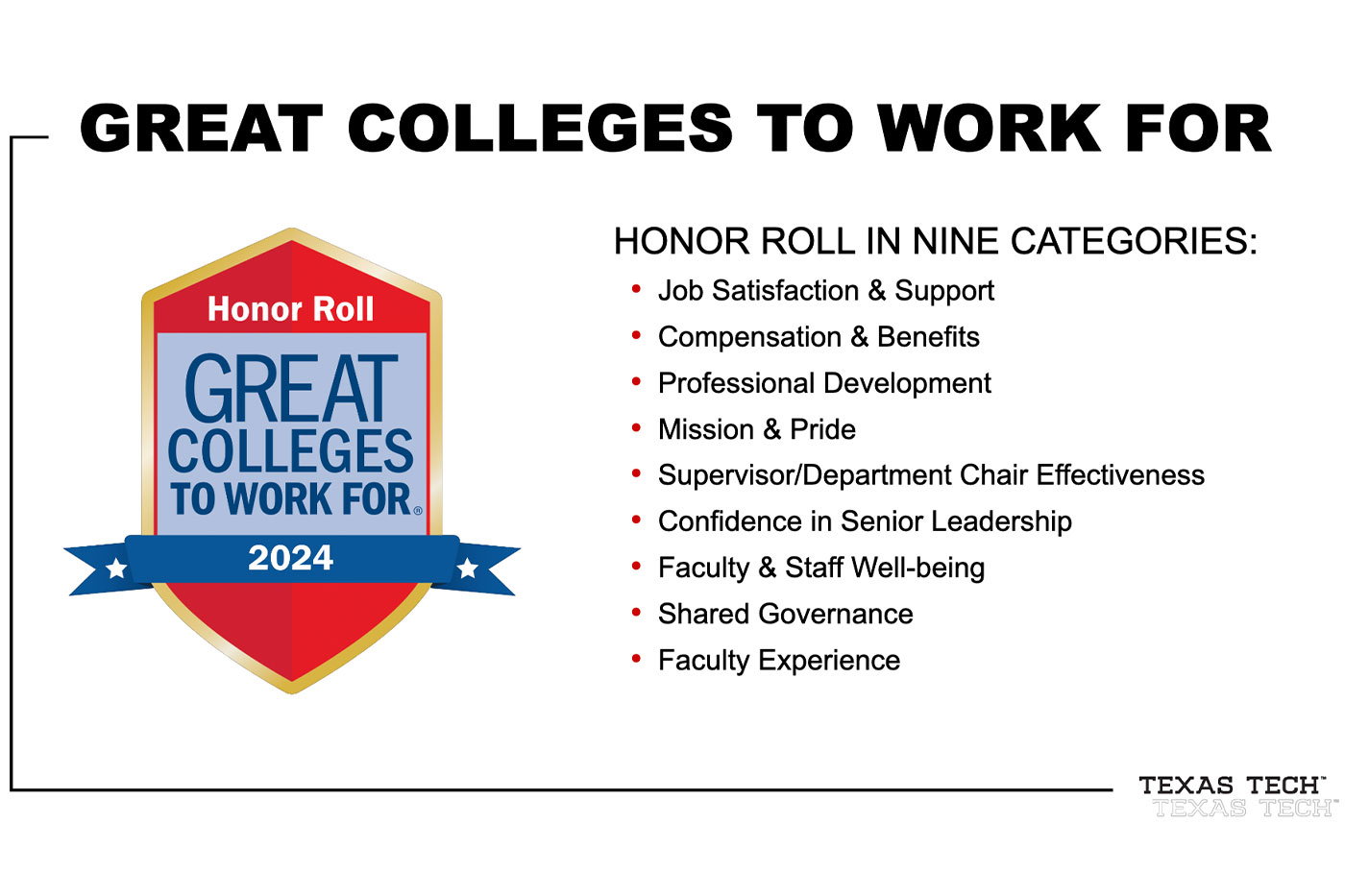
This culture of excellence and collaboration has continued to earn Texas Tech recognition as a “Great College to Work For® for the sixth time and an Honor Roll designee for the third year in a row, indicating the university was cited most frequently across all recognition categories.
“These efforts, including those by the faculty and staff just mentioned, will not only bring us closer to our goal of joining the AAU, but more importantly, they will strengthen this university in ways that will benefit generations of students and scholars to come,” Schovanec said.
The path toward AAU status will also enhance Texas Tech’s identity throughout the world. Two initiatives throughout the campus have already forged that path.
This year, Texas Tech introduced a new visual identity system, the first update to the university’s visual identity in almost 20 years. The new branding reflects the institution’s evolving ambitions while honoring Texas Tech’s rich heritage and ensuring its message resonates clearly and powerfully.
Also, this summer, Texas Tech Athletics announced a 10-year partnership with adidas, which promises to elevate Red Raider and Lady Raider sports programs and enhance their competitive edge. This comes as Texas Tech completes a major renovation and expansion of Jones AT&T Stadium and Womble Football Facility.
Schovanec said he is optimistic the initiatives being undertaken will lay the foundation for growth in prominence, impact and excellence as a leader in higher education.
“At this university, we say what we mean and do what we say,” Schovanec said. “Whatever it takes, we will get it done. Our commitment is steadfast, our impact is meaningful, and our future is bright.”

